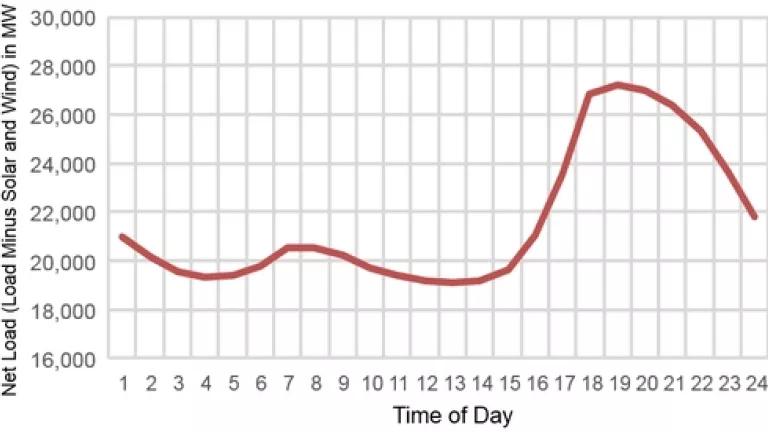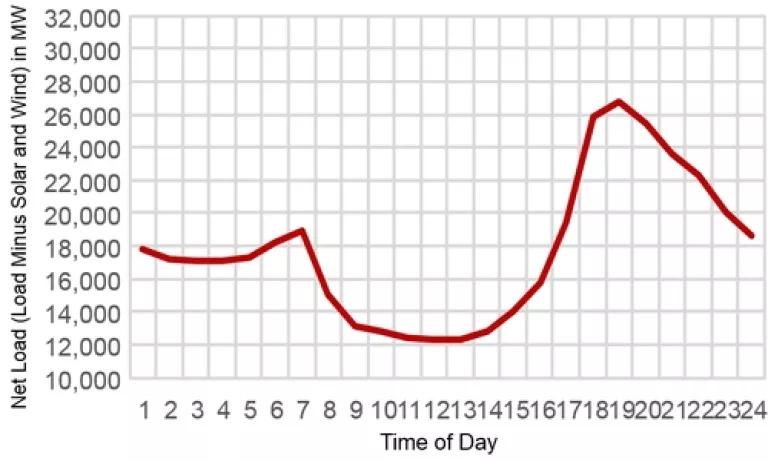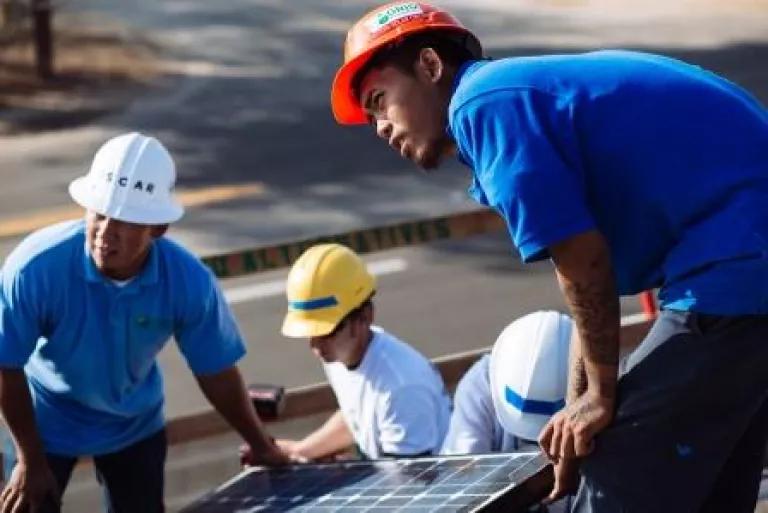
Did you know that the amount of electricity we need from the electric grid now can reach its lowest point in the middle of the day instead of the middle of the night when people are asleep and businesses are closed?
Historically, 4 a.m. was the time requiring the least amount of electricity from the grid, which makes sense. But over the past few months, that lowest point has been around 1 p.m. sometimes. Why would that be?
What's happening is that the electricity grid is in the middle of being reinvented for our low-carbon future. And we are watching it happen right now. Massive amounts of clean energy (like wind turbines and solar panels that produce no air pollution) have come online in the last few years. These new energy resources are providing vast quantities of clean energy during the day and the night. But solar panels in particular, only produce energy during the day, when the sun is shining. And it's that emissions-free solar energy that is reinventing how the grid brings electricity service to our homes and businesses.
The New Normal
During the day, California routinely gets more than 15 percent of its power needs from solar energy, which produces no harmful air pollution. That's enormously helpful for our environment and the health of people like you and me. It also means that the people who operate the grid don't need to find as much electricity elsewhere to power all the homes, businesses, and factories in California. You see, solar electricity must be used when it's produced: the grid operators must take all the electricity that the solar panels are sending to the grid. That's much different from other resources on the grid (like a gas plant) where the operator can request from the plant only how much electricity it needs.
When you factor in all this solar energy (in addition to the pollution-free energy from wind turbines, which also must be used immediately), you get a better picture of how much electricity will then need to be acquired from all the other resources on the grid, such as from polluting natural gas. (For all you energy geeks out there, this is "net load.") And that picture shows something never seen before in California: the amount of electricity that the operator needs from the grid being lowest in the middle of the day. Take a look at what has become the new normal on weekend days this winter:
Average Weekend Day "Net Load" Profile in December 2014
You can see that in the middle of the day we actually need slightly less electricity from the grid than during the middle of the night. This is the case for an average weekend this winter, and for some weekdays presently. (During the weekday relatively more electricity is demanded during the middle of the day.) But this is just the tip of the iceberg. In the future, this will also be the case for almost all weekdays, and on weekends we'll need even less of that midday electricity generated from other sources:
Projections for Average Weekend "Net Load" in December 2021

In fact, there is so much solar energy that the current grid architecture in California isn't always able to absorb all this pollution-free energy and make good use of it. If the electric grid isn't updated, we'll end up throwing away this clean solar energy that costs virtually nothing to produce (since the solar panels are up and running). And that's actually what we're doing now, throwing away solar energy - which is a colossal waste. And it's even worse when you consider this means grid operators have to turn to polluting power plants instead that harm our health and the environment.
Good News: We Have Solutions
Fortunately, we know how to avoid this waste. We can improve the grid in a number of ways, like: upgrading our buildings and making sure our appliances waste less energy in those evening hours (energy efficiency), which can enable the grid to accept more mid-day electricity from solar generation; paying people and businesses to shift when they do energy-intensive activities (demand response); ensuring that other people in the western United States can access our solar energy when we're producing it and they need it (balancing area coordination); and storing this energy in the middle of the day so that it's available in the evening (energy storage).

These solutions will all require work, but we are already seeing progress. For example, the most recent catastrophic event to hit the California electric system was the malfunction and subsequent retirement of an enormous nuclear power plant in southern California, called the San Onofre Nuclear Generating Station (SONGS). How did the California state agency in charge respond? It decided to replace SONGS with predominantly clean energy resources to serve the needs of southern California customers. Under the leadership of California Public Utilities Commissioner Mike Florio, and in an unprecedented move, the agency ordered electric utilities that once relied on the SONGS plant to serve their customers to now invest in a slew of clean energy resources, including a mandatory 50 megawatts of energy storage to make sure we're not throwing away clean, renewable energy like wind and solar during the day.
What happened after this groundbreaking decision? The first utility to report results, Southern California Edison, came back with over five-times the amount of required storage: 260 MW of energy storage - the largest purchase ever of this type of energy storage. The utilities were also required to purchase other clean energy resources to provide energy services, and Southern California Edison brought back substantial amounts of those, like energy efficiency and demand response. These are all exactly the type of resources that we need to modernize the electric grid.
A Path Forward
We have now seen that California's needs for more electricity to be generated and transmitted to our homes and businesses can be lower in the day than at night, and that we need solutions to avoid throwing away clean energy in the middle of the day.
But we are only at the beginning of inventing the electric grid of the future. Unexpected technologies will continue to surface, along with unexpected challenges. Our state energy agencies will need to adapt to these new normals and our leaders will need to enact bold solutions.
That much is still as clear as day and night.
